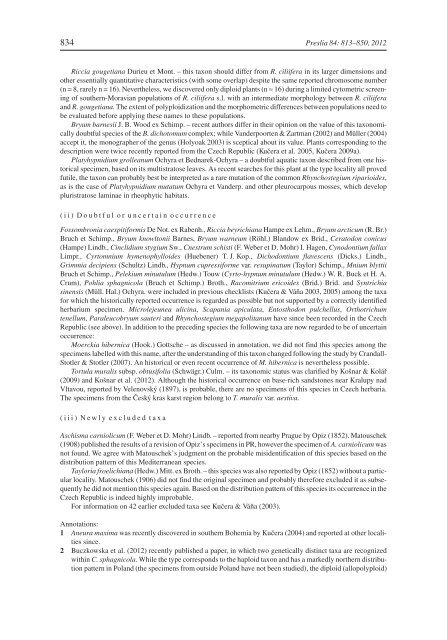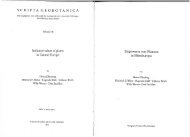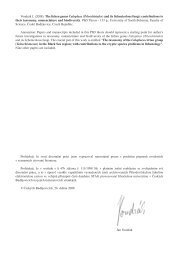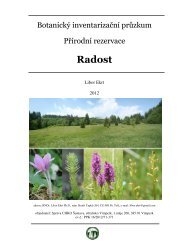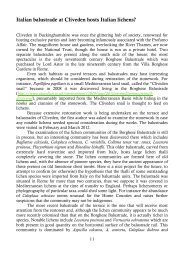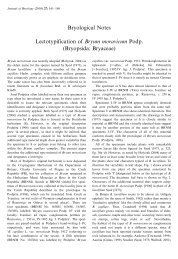Bryophyte flora of the Czech Republic: updated checklist and Red ...
Bryophyte flora of the Czech Republic: updated checklist and Red ...
Bryophyte flora of the Czech Republic: updated checklist and Red ...
You also want an ePaper? Increase the reach of your titles
YUMPU automatically turns print PDFs into web optimized ePapers that Google loves.
834 Preslia 84: 813–850, 2012<br />
Riccia gougetiana Durieu et Mont. – this taxon should differ from R. ciliifera in its larger dimensions <strong>and</strong><br />
o<strong>the</strong>r essentially quantitative characteristics (with some overlap) despite <strong>the</strong> same reported chromosome number<br />
(n = 8, rarely n = 16). Never<strong>the</strong>less, we discovered only diploid plants (n ≈ 16) during a limited cytometric screening<br />
<strong>of</strong> sou<strong>the</strong>rn-Moravian populations <strong>of</strong> R. ciliifera s.l. with an intermediate morphology between R. ciliifera<br />
<strong>and</strong> R. gougetiana. The extent <strong>of</strong> polyploidization <strong>and</strong> <strong>the</strong> morphometric differences between populations need to<br />
be evaluated before applying <strong>the</strong>se names to <strong>the</strong>se populations.<br />
Bryum barnesii J. B. Wood ex Schimp. – recent authors differ in <strong>the</strong>ir opinion on <strong>the</strong> value <strong>of</strong> this taxonomically<br />
doubtful species <strong>of</strong> <strong>the</strong> B. dichotomum complex; while V<strong>and</strong>erpoorten & Zartman (2002) <strong>and</strong> Müller (2004)<br />
accept it, <strong>the</strong> monographer <strong>of</strong> <strong>the</strong> genus (Holyoak 2003) is sceptical about its value. Plants corresponding to <strong>the</strong><br />
description were twice recently reported from <strong>the</strong> <strong>Czech</strong> <strong>Republic</strong> (Kučera et al. 2005, Kučera 2009a).<br />
Platyhypnidium grolleanum Ochyra et Bednarek-Ochyra – a doubtful aquatic taxon described from one historical<br />
specimen, based on its multistratose leaves. As recent searches for this plant at <strong>the</strong> type locality all proved<br />
futile, <strong>the</strong> taxon can probably best be interpreted as a rare mutation <strong>of</strong> <strong>the</strong> common Rhynchostegium riparioides,<br />
as is <strong>the</strong> case <strong>of</strong> Platyhypnidium mutatum Ochyra et V<strong>and</strong>erp. <strong>and</strong> o<strong>the</strong>r pleurocarpous mosses, which develop<br />
pluristratose laminae in rheophytic habitats.<br />
(ii) Doubtful or uncertain occurrence<br />
Fossombronia caespitiformis De Not. ex Rabenh., Riccia beyrichiana Hampe ex Lehm., Bryum arcticum (R. Br.)<br />
Bruch et Schimp., Bryum knowltonii Barnes, Bryum warneum (Röhl.) Bl<strong>and</strong>ow ex Brid., Ceratodon conicus<br />
(Hampe) Lindb., Cinclidium stygium Sw., Cnestrum schisti (F. Weber et D. Mohr) I. Hagen, Cynodontium fallax<br />
Limpr., Cyrtomnium hymenophylloides (Huebener) T. J. Kop., Dichodontium flavescens (Dicks.) Lindb.,<br />
Grimmia decipiens (Schultz) Lindb., Hypnum cupressiforme var. resupinatum (Taylor) Schimp., Mnium blyttii<br />
Bruch et Schimp., Pelekium minutulum (Hedw.) Touw (Cyrto-hypnum minutulum (Hedw.) W. R. Buck et H. A.<br />
Crum), Pohlia sphagnicola (Bruch et Schimp.) Broth., Racomitrium ericoides (Brid.) Brid. <strong>and</strong> Syntrichia<br />
sinensis (Müll. Hal.) Ochyra. were included in previous <strong>checklist</strong>s (Kučera & Váňa 2003, 2005) among <strong>the</strong> taxa<br />
for which <strong>the</strong> historically reported occurrence is regarded as possible but not supported by a correctly identified<br />
herbarium specimen. Microlejeunea ulicina, Scapania apiculata, Entosthodon pulchellus, Orthotrichum<br />
tenellum, Paraleucobryum sauteri <strong>and</strong> Rhynchostegium megapolitanum have since been recorded in <strong>the</strong> <strong>Czech</strong><br />
<strong>Republic</strong> (see above). In addition to <strong>the</strong> preceding species <strong>the</strong> following taxa are now regarded to be <strong>of</strong> uncertain<br />
occurrence:<br />
Moerckia hibernica (Hook.) Gottsche – as discussed in annotation, we did not find this species among <strong>the</strong><br />
specimens labelled with this name, after <strong>the</strong> underst<strong>and</strong>ing <strong>of</strong> this taxon changed following <strong>the</strong> study by Cr<strong>and</strong>all-<br />
Stotler & Stotler (2007). An historical or even recent occurrence <strong>of</strong> M. hibernica is never<strong>the</strong>less possible.<br />
Tortula muralis subsp. obtusifolia (Schwägr.) Culm. – its taxonomic status was clarified by Košnar & Kolář<br />
(2009) <strong>and</strong> Košnar et al. (2012). Although <strong>the</strong> historical occurrence on base-rich s<strong>and</strong>stones near Kralupy nad<br />
Vltavou, reported by Velenovský (1897), is probable, <strong>the</strong>re are no specimens <strong>of</strong> this species in <strong>Czech</strong> herbaria.<br />
The specimens from <strong>the</strong> Český kras karst region belong to T. muralis var. aestiva.<br />
(iii) Newly excluded taxa<br />
Aschisma carniolicum (F. Weber et D. Mohr) Lindb. – reported from nearby Prague by Opiz (1852). Matouschek<br />
(1908) published <strong>the</strong> results <strong>of</strong> a revision <strong>of</strong> Opiz’s specimens in PR, however <strong>the</strong> specimen <strong>of</strong> A. carniolicum was<br />
not found. We agree with Matouschek’s judgment on <strong>the</strong> probable misidentification <strong>of</strong> this species based on <strong>the</strong><br />
distribution pattern <strong>of</strong> this Mediterranean species.<br />
Tayloria froelichiana (Hedw.) Mitt. ex Broth. – this species was also reported by Opiz (1852) without a particular<br />
locality. Matouschek (1906) did not find <strong>the</strong> original specimen <strong>and</strong> probably <strong>the</strong>refore excluded it as subsequently<br />
he did not mention this species again. Based on <strong>the</strong> distribution pattern <strong>of</strong> this species its occurrence in <strong>the</strong><br />
<strong>Czech</strong> <strong>Republic</strong> is indeed highly improbable.<br />
For information on 42 earlier excluded taxa see Kučera & Váňa (2003).<br />
Annotations:<br />
1 Aneura maxima was recently discovered in sou<strong>the</strong>rn Bohemia by Kučera (2004) <strong>and</strong> reported at o<strong>the</strong>r localities<br />
since.<br />
2 Buczkowska et al. (2012) recently published a paper, in which two genetically distinct taxa are recognized<br />
within C. sphagnicola. While <strong>the</strong> type corresponds to <strong>the</strong> haploid taxon <strong>and</strong> has a markedly nor<strong>the</strong>rn distribution<br />
pattern in Pol<strong>and</strong> (<strong>the</strong> specimens from outside Pol<strong>and</strong> have not been studied), <strong>the</strong> diploid (allopolyploid)


